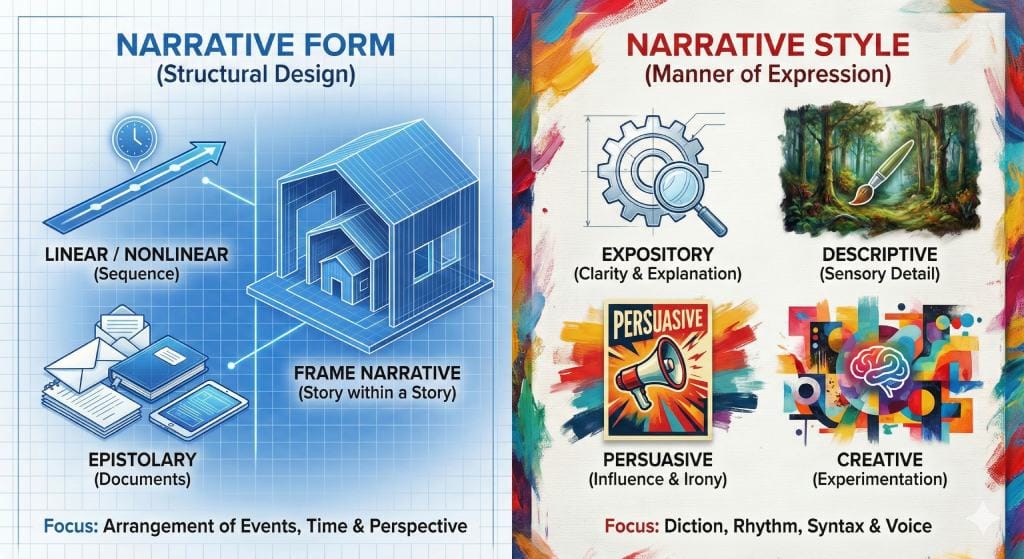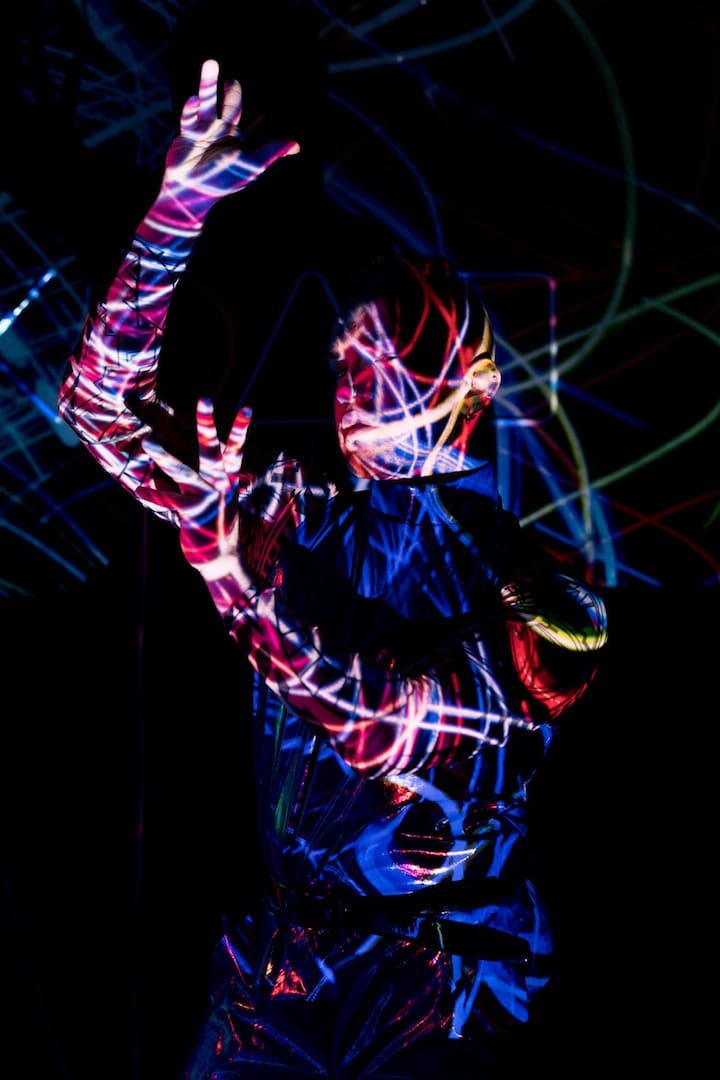Understanding the difference between “narrative form” and “narrative style” is essential for appreciating how literature functions. Though often conflated, these two terms describe distinct elements of storytelling. Narrative form refers to the structural design of a story. Narrative style refers to the manner in which the story is expressed. Writers may experiment with either or both. This produces pieces that are strikingly original or firmly within established traditions.
What is Narrative Form?
Narrative form is the structural principle that imposes a particular order upon a story’s raw material. It determines how events are ordered, how characters are introduced, and how time is arranged. A story without form risks feeling like a set of disconnected fragments; form imparts integrity, direction, and a coherent, apprehensible structure.
Writers have long experimented with form to achieve different effects. Some rely on straightforward chronology to create clarity and momentum, while others segment or rearrange time to mirror memory, perception, or upheaval. Still others enclose stories within other stories or build them through documents and letters. These choices show that form is not just an external frame but a careful design that influences how a work is experienced.
Types of Narrative Forms
- Linear and nonlinear narratives: Linear forms create order through time, reinforcing causality. Events move chronologically, as in Jane Austen’s Pride and Prejudice (1813). Nonlinear forms interrupt chronology to reflect memory, perspective, or thematic severance. William Faulkner and Virginia Woolf exemplify this structure. They employ shifts in time to echo consciousness.
- Frame narratives: Frame structures guide interpretation by embedding one account inside another, a story within a story. Geoffrey Chaucer’s The Canterbury Tales (late 14th century) offers an early example, while Joseph Conrad’s Heart of Darkness (1899) frames Marlow’s tale within a conversation on the Thames, highlighting how stories are mediated by perspective.
- Epistolary narratives: The epistolary form unfolds through documents such as letters, diaries, or digital texts. Mary Shelley’s Frankenstein (1818) uses this structure, while Bram Stoker’s Dracula (1897) expands it with a mix of journals, correspondence, and newspaper clippings, creating the effect of piecing together scattered evidence.
What is Narrative Style?
Narrative style refers to the distinctive manner of telling a story. While form organizes structure, style operates at the level of diction, rhythm, syntax, and voice. Ernest Hemingway’s spare prose contrasts with the elaborate sentences of Henry James. Both may employ linear forms, yet their styles create radically different effects.
Narrative style also determines tone and atmosphere. Franz Kafka’s disturbing precision in The Trial (1925) differs from the lyrical intensity of Arundhati Roy’s The God of Small Things (1997). Style directs the texture of language and affects how readers perceive the narrative world.
Types of Narrative Styles
- Expository narrative style: Expository style prioritizes clarity and explanation. It often appears in historical novels where context must be established. Leo Tolstoy’s War and Peace (1869) uses expository passages to frame political and military detail.
- Descriptive narrative style: Descriptive style lingers on detail to immerse the reader. Thomas Hardy in Tess of the d’Urbervilles (1891) builds atmosphere through richly observed landscapes that mirror Tess’s struggles.
- Persuasive narrative style: Persuasive style tries to sway belief. Jonathan Swift’s A Modest Proposal (1729), while technically a satirical essay, functions as narrative persuasion through irony.
- Creative narrative style: Creative style foregrounds experimentation. James Joyce’s Ulysses (1922) blends stream of consciousness, parody, and shifting registers, exemplifying stylistic invention.
Clarifying Related Concepts
Narrative Voice vs. Narrative Style
Though related, narrative voice and narrative style differ. Narrative voice refers to the perspective from which the story is told, whether first person, third person, or omniscient. Style, by contrast, is the manner in which that voice is expressed. For example, in J. D. Salinger’s The Catcher in the Rye (1951), Holden Caulfield’s first-person voice is inseparable from his colloquial style. Yet a third-person narrator, such as in George Eliot’s Middlemarch (1871–72), may vary between objective commentary and intimate psychological observation.
For an expanded look at narrative point of view, see Points of View: A Comprehensive Guide, which examines the various perspectives authors employ to guide storytelling.
Narrative Form vs. Narrative Structure
The terms “narrative form” and “narrative structure” sometimes overlap but are not identical. Structure refers more specifically to the arrangement of events, while form encompasses the larger organizing principle. For example, Homer’s Odyssey (c. 8th century BCE) uses episodic structure within the overarching form of an epic.
To explore narrative structure in greater detail (and from the reader’s perspective), see the article Understanding Narrative Structure, which discusses how arrangement of events works within broader narrative forms.
Narrative Type (Genre) vs. Structural Design
While narrative form refers to the story’s internal structural design, the term “narrative type” is used in publishing to categorize the text based on mode and length. For example, the types novel, short story, and essay classify the external mode of the text. This is a crucial separation. A work’s external type does not limit its internal structure. A novel (type) can use a three-act outline (structure), or it can employ a frame narrative (form). The external type determines length and scope, while the structural design determines the arrangement of events (via structure and form) within that scope.
Narrative Techniques and Devices
Writers often use techniques that blend form and style. Stream of consciousness, as in Woolf’s Mrs. Dalloway (1925), merges structural experimentation with stylistic rhythm. Unreliable narration, seen in Kazuo Ishiguro’s The Remains of the Day (1989), combines first-person voice with stylistic restraint to reveal self-deception. These techniques highlight the interplay between structural choice and stylistic execution.
Ultimately, knowing the distinction between narrative form and style illuminates how literature achieves its effects. Form governs how stories are built, whether through frames, letters, or disrupted chronology. Style determines how those stories feel through voice, syntax, and diction. Together, they create the interplay that makes each work distinctive.
For a fuller discussion of key methods authors use, see 10 Narrative Techniques of Great Stories, which outlines approaches that determine the construction and effect of stories across genres.
Further Reading
What is the difference between narrative and style? on Quora




